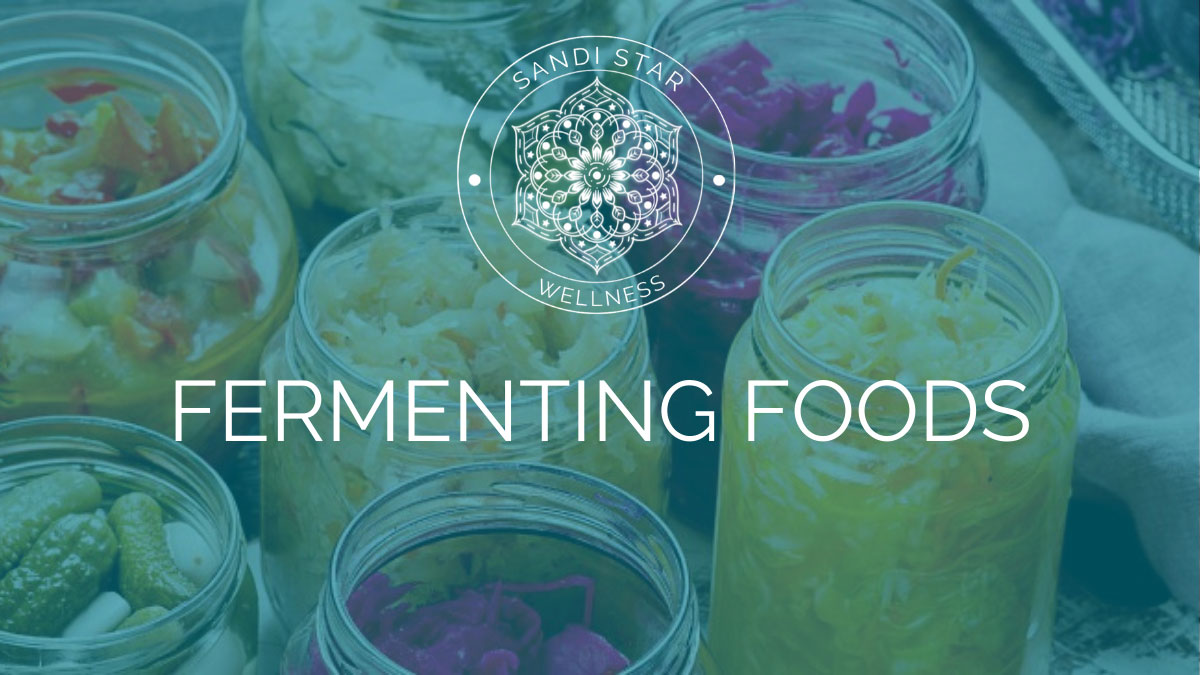
26 Jan Fermenting Foods
I have to admit I do not like sauerkraut to say the least but when I tried a fresh batch at a farmer’s market, it changed my mind. Making it fresh is a lot different than buying your typical canned sauerkraut off the shelf. In addition, when I initially started fermenting veggies I thought it would be a long, complicated process and again I was proven wrong. I had a friend show me how to do it and was blown away at how easy it is and how inexpensive. If you were to buy a small jar of sauerkraut at the market it would cost, you $10. You can make a huge container of it for the cost of a head of organic cabbage and a pinch of salt. I immediately bought a fermenting pot at the farmer’s market hand made by a local guy (Falcon Pottery) who I’m happy to support anyhow. It was an investment of $80 for the big pot which I have since wished I bought a smaller one. My friends are quite happy when I make a batch because there is plenty to go around. By the way, these make great Hostess gifts. You don’t have to use a fermenting pot. All you need is a large glass mason jar with a wide mouth. Once you get into it and if it’s something you want to continue doing then by all means purchase one of the beautiful fermenting pots. I have since started doing my own kefir and Kampuchea tea (another article worth writing). Beware – fermenting can become addictive. It’s exciting to do science projects you can enjoy and are beneficial for your health. Always start with eating small amounts. All you need is a tablespoon a day to start. You can also drink a small amount of the juice; especially if you have a very inflamed gut and can’t eat raw foods. For example, someone with Crohn’s can do a little juice a day but would want to stay away from the veggies.
WHAT ARE FERMENTED VEGETABLES?
Fermented vegetables begin with lacto-fermentation, a method of food preservation that also enhances the nutrient content of the food. The action of the bacteria makes the minerals in cultured foods more readily available to the body. The bacteria also produce vitamins and enzymes that are beneficial for digestion.
Almost any vegetable can be fermented, and fermenting farm-fresh produce is a great way to provide good nutrition year-round! Ferment one vegetable alone or create mix of many different kinds, along with herbs and spices, for a great variety of cultured foods. The last batch I made had an array of veggies including cabbage (both red and white), ginger, carrots, jalapeno peppers, garlic and some great spices such as dill, mustard seeds, fennel and peppercorns.
LACTIC BACTERIA
Most people think about beer or wine when they hear the term fermentation. While certain yeasts are used to convert the sugars in grape juice or grains into alcohol, it is bacteria that are responsible for lacto-fermentation. The “lacto” portion of the term refers to a specific species of bacteria, namely Lactobacillus. Various strains of these bacteria are present on the surface of all plants, especially those growing close to the ground, and are also common to the gastrointestinal tracts, mouths, and vaginas of humans and other animal species.
Lactobacillus bacteria have the ability to convert sugars into lactic acid. The Lactobacillus strain is so named because it was first studied in milk ferments. These bacteria readily use lactose or other sugars and convert them quickly and easily to lactic acid. However, lacto-fermentation does not necessarily need to involve dairy products. That is great news as most people with GI disorders do not digest cow dairy well.
Lactic acid is a natural preservative that inhibits the growth of harmful bacteria. Beyond preservation advantages, lacto-fermentation also increases or preserves the vitamin and enzyme levels, as well as digestibility, of the fermented food. In addition, lactobacillus organisms are heavily researched for substances that may contribute to good health. [1]
FERMENTED FOODS
The diets of every traditional society goes way back and has included some kind of lacto-fermented food. Remember, refrigeration has only been around for 150 years. Europeans consume lacto-fermented dairy, sauerkraut, grape leaves, herbs, and root vegetables. The Alaskan Inuit ferment fish and sea mammals. The Orient is known for pickled vegetables, sauces, and kimchi in particular. Farming societies in central Africa are known for porridges made from soured grains.
Pickles and relishes are a part of the American food tradition. Since the advent of industrialization, most pickling is done with vinegar, which offers more predictable results, but no lactic acid. The important thing is not to be intimidated by lacto-fermentation. Unless it smells unmistakably putrid (in which case common sense says throw it away), fermented foods are some of the safest foods. They are easy for even a beginner to prepare, and it doesn’t take long to gain enough confidence to venture beyond basic yogurt or sauerkraut to an endless variety of vegetables and fruits, beverages and more. My advice – start simple and once you get comfortable doing fermented vegetables move on and try something else like Kefir.
Here is a great recipe from The Kitchen.com and a list of some great sites to visit for more recipes, tips and information about fermenting.
How to Make Homemade Sauerkraut in a Mason Jar
Makes 1 to 1 1/2 quarts
What You Need
Ingredients
1 medium head green cabbage (about 3 pounds)
1 1/2 tablespoons kosher salt
1 tablespoon caraway seeds (optional, for flavor)
Equipment
Cutting board
Chef’s knife
Mixing bowl
2-quart wide-mouth canning jar (or two-quart mason jars)
Canning funnel (optional)
Smaller jelly jar that fits inside the larger mason jar
Clean stones, marbles, or other weights for weighing the jelly jar
Cloth for covering the jar
Rubber band or twine for securing the cloth
Instructions
1. Clean everything: When fermenting anything, it’s best to give the good, beneficial bacteria every chance of succeeding by starting off with as clean an environment as possible. Make sure your mason jar and jelly jar are washed and rinsed of all soap residue. You’ll be using your hands to massage the salt into the cabbage, so give those a good wash, too.
2. Slice the cabbage: Discard the wilted, limp outer leaves of the cabbage. Cut the cabbage into quarters and trim out the core. Slice each quarter down its length, making 8 wedges. Slice each wedge crosswise into very thin ribbons.
3. Combine the cabbage and salt: Transfer the cabbage to a big mixing bowl and sprinkle the salt over top. Begin working the salt into the cabbage by massaging and squeezing the cabbage with your hands. At first it might not seem like enough salt, but gradually the cabbage will become watery and limp — more like coleslaw than raw cabbage. This will take 5 to 10 minutes. If you’d like to flavor your sauerkraut with caraway seeds, mix them in now.
4. Pack the cabbage into the jar: Grab handfuls of the cabbage and pack them into the canning jar. If you have a canning funnel, this will make the job easier. Every so often, tamp down the cabbage in the jar with your fist. Pour any liquid released by the cabbage while you were massaging it into the jar. →Optional: Place one of the larger outer leaves of the cabbage over the surface of the sliced cabbage. This will help keep the cabbage submerged in its liquid.
5. Weigh the cabbage down: Once all the cabbage is packed into the mason jar, slip the smaller jelly jar into the mouth of the jar and weigh it down with clean stones or marbles. This will help keep the cabbage weighed down, and eventually, submerged beneath its liquid.
6. Cover the jar: Cover the mouth of the mason jar with a cloth and secure it with a rubber band or twine. This allows air to flow in and out of the jar, but prevents dust or insects from getting into the jar.
7. Press the cabbage every few hours: Over the next 24 hours, press down on the cabbage every so often with the jelly jar. As the cabbage releases its liquid, it will become more limp and compact and the liquid will rise over the top of the cabbage.
8. Add extra liquid, if needed: If after 24 hours, the liquid has not risen above the cabbage, dissolve 1 teaspoon of salt in 1 cup of water and add enough to submerge the cabbage.
9. Ferment the cabbage for 3 to 10 days: As it’s fermenting, keep the sauerkraut away from direct sunlight and at a cool room temperature — ideally 65°F to 75°F. Check it daily and press it down if the cabbage is floating above the liquid. Because this is a small batch of sauerkraut, it will ferment more quickly than larger batches. Start tasting it after 3 days — when the sauerkraut tastes good to you, remove the weight, screw on the cap, and refrigerate. You can also allow the sauerkraut to continue fermenting for 10 days or even longer. There’s no hard-and-fast rule for when the sauerkraut is “done” — go by how it tastes. While it’s fermenting, you may see bubbles coming through the cabbage, foam on the top, or white scum. These are all signs of a healthy, happy fermentation process. The scum can be skimmed off the top either during fermentation or before refrigerating. If you see any mold, skim it off immediately and make sure your cabbage is fully submerged; don’t eat moldy parts close to the surface, but the rest of the sauerkraut is fine.
10. Store sauerkraut for several months: This sauerkraut is a fermented product so it will keep for at least two months and often longer if kept refrigerated. As long as it still tastes and smells good to eat, it will be. If you like, you can transfer the sauerkraut to a smaller container for longer storage.
Recipe Notes
• Sauerkraut with other cabbages: Red cabbage, napa cabbage, and other cabbages all make great sauerkraut. Make individual batches or mix them up for a multi-colored sauerkraut!
• Canning sauerkraut: You can process sauerkraut for longer storage outside of refrigeration, but the canning process will kill the good bacterias produced by the fermentation process. See this tutorial from the National Center for Home Food Preservation for canning instructions.
• Larger or smaller batches: To make larger or smaller batches of sauerkraut, keep same ratio of cabbage to salt and adjust the size of the container. Smaller batches will ferment more quickly and larger batches will take longer.
• Hot and cold temperatures: Do everything you can to store sauerkraut at a cool room temperature. At high temperatures, the sauerkraut can sometimes become unappetizingly mushy or go bad. Low temperatures (above freezing) are fine, but fermentation will proceed more slowly.
Great Sites to visit for videos and recipes:
https://cityhomesteads.com/how-to-ferment-vegetables/
http://www.thekitchn.com/how-to-make-homemade-sauerkraut-in-a-mason-jar-193124
http://paleoleap.com/fermented-food-recipes/
http://nourishedkitchen.com/homemade-sauerkraut/
http://wellnessmama.com/663/homemade-sauerkraut/
http://www.culturesforhealth.com/learn/natural-fermentation/how-to-ferment-vegetables/


